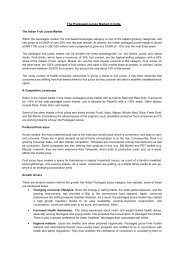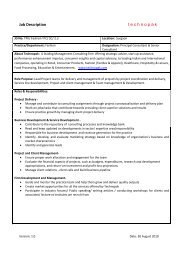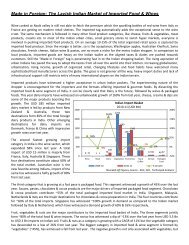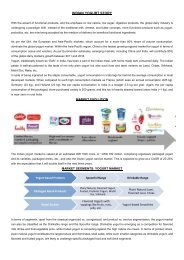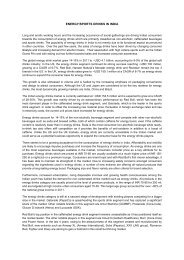a quarterly report by - Technopak
a quarterly report by - Technopak
a quarterly report by - Technopak
You also want an ePaper? Increase the reach of your titles
YUMPU automatically turns print PDFs into web optimized ePapers that Google loves.
perspective<br />
a quar terly repor t <strong>by</strong><br />
Volume 02 / 2009<br />
| Volume 02<br />
• Increased Scale: India should develop large scale industrial zones (area > 100-200 sq. kms.) with all<br />
the facilities and business friendly environment in place. Although many SEZ’s and Integrated Textile<br />
Parks (ITPs) have been planned on similar line, there needs to be faster development on these areas<br />
and scale needs to be increased for these zones so as to establish entire supply chain for various textile<br />
activities.<br />
• Ready Made Infrastructure: Industrial zones in India should approach foreign investors only after<br />
establishment of all support infrastructures and with proper homework in terms of incentives / benefits,<br />
well laid out and definite plans and offerings to the investors.<br />
• Single Window Clearance: At the implementation level, the government needs to devise a mechanism<br />
to have single window clearance and single approval for all aspects of starting a business. This would<br />
go a long way in reducing the time taken for starting business in India and encourage investors to look at<br />
India as a favorable investment destination.<br />
• Clearance of Applications: Application clearance under the Incentive schemes like Technology Upgradation<br />
Fund Scheme and speeding up the process of establishing Free Trade Agreements with<br />
European Union would also help in attracting European investors to invest in India.<br />
• Investor Friendly Environment: There needs to be a major drive undertaken to reduce red-tape and<br />
bureaucracy in the system. A more investor friendly environment needs to be built to add to all the existing<br />
inherent strengths of the Indian textile industry. On the annual Corruption Perception Index, India’s score<br />
has remained the same for two consecutive years at 2.7. In the same period Pakistan improved from 2.3<br />
to 2.6 and China from 3.1 to 3.5. The higher the score, the less corrupt is the country.<br />
Conclusion<br />
India is poised to become an even bigger participant on the global front, both as a consumer and as<br />
a producer. The large domestic market is very attractive and as a base for the low cost production is a<br />
combination not offered <strong>by</strong> many nations at this point of time. However, in order to become a leading FDI<br />
destination in the textile and apparel sector, a lot needs to be done. The Government needs to work on a<br />
focused ‘Pull Strategy’. The way ahead is to identify and highlight the key strengths, the available resources<br />
and the large growing domestic market through focused marketing efforts.<br />
Authors<br />
Prashant Agarwal, Vice President I prashant.agarwal@technopak.com<br />
Luv Jasuja, Principal Consultant I luv.jasuja@technopak.com<br />
Rohit Nasa, Senior Consultant I rohit.nasa@technopak.com<br />
FDI : A Catalyst for Growth of the Textile & Apparel Industry |<br />
38



